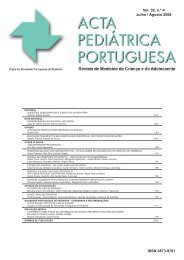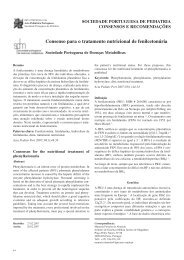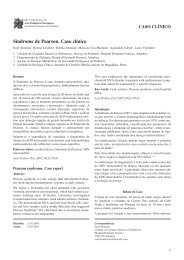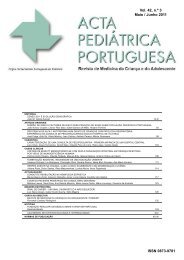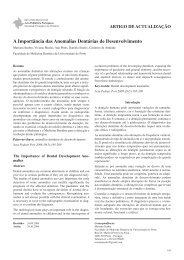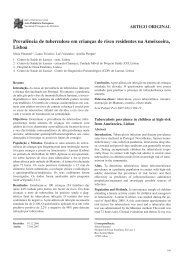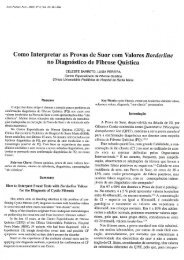acta pediátrica portuguesa - Sociedade Portuguesa de Pediatria
acta pediátrica portuguesa - Sociedade Portuguesa de Pediatria
acta pediátrica portuguesa - Sociedade Portuguesa de Pediatria
You also want an ePaper? Increase the reach of your titles
YUMPU automatically turns print PDFs into web optimized ePapers that Google loves.
Acta Pediatr Port 2010:41(5):S1<br />
Resumos dos Oradores<br />
Conferência_1<br />
WHO Child Growth Standards for children 0-5 years<br />
Dr Merce<strong>de</strong>s <strong>de</strong> Onis 1<br />
1<br />
Department of Nutrition, World Health Organization, Geneva, Switzerland.<br />
Summary<br />
The origin of the WHO Child Growth Standards dates back to the early 1990s<br />
and a meticulous evaluation of the NCHS growth reference, which had been<br />
recommen<strong>de</strong>d for international use since the late 1970s. The review documen -<br />
ted the <strong>de</strong>ficiencies of the reference and led to a plan for <strong>de</strong>veloping new<br />
growth charts that would <strong>de</strong>pict how children should grow in all countries<br />
rather than merely <strong>de</strong>scribing how they grew at a particular time and place.<br />
The outcome of this plan was the WHO Multicentre Growth Reference Study<br />
(1997-2003), which applied rigorous methods of data collection and serves as<br />
a mo<strong>de</strong>l of collaboration for conducting international research. The study provi<strong>de</strong>s<br />
a solid foundation for <strong>de</strong>veloping a standard because the sample is based<br />
on healthy children living un<strong>de</strong>r conditions likely to favour achievement of<br />
their full genetic growth potential. Furthermore, the mothers of the children<br />
selected for the construction of the standards engaged in fundamental healthpromoting<br />
practices, namely breastfeeding and not smoking. Other important<br />
features of the study are that it inclu<strong>de</strong>d children from a diverse set of countries<br />
(Brazil, Ghana, India, Norway, Oman and USA) and explicitly i<strong>de</strong>ntified<br />
breastfeeding as the biological norm and established the breastfed child as the<br />
normative mo<strong>de</strong>l for growth and <strong>de</strong>velopment. By replacing the NCHS refe -<br />
rence, which is based on children from a single country, with one based on an<br />
international group of children, the new standards recognize that children the<br />
world over grow similarly when their health and care needs are met. The WHO<br />
Child Growth Standards provi<strong>de</strong> a technically robust tool for assessing the<br />
well-being of infants and young children. The standards <strong>de</strong>pict normal growth<br />
un<strong>de</strong>r optimal environmental conditions and can be used to assess children<br />
everywhere, regardless of ethnicity, socioeconomic status and type of feeding.<br />
Introduction<br />
A<strong>de</strong>quate nutrition during the early years of life is of paramount importance for<br />
growth, <strong>de</strong>velopment and long-term health through adulthood. It is during infancy<br />
and early childhood that irreversible faltering in linear growth and cognitive<br />
<strong>de</strong>ficits occur [1,2]. Poor nutrition during this critical period contributes to significant<br />
morbidity and mortality [3]. Similarly, the increasing prevalence of<br />
child hood obesity worldwi<strong>de</strong> is associated with an increased risk of unfa vou -<br />
rable health outcomes later in life and <strong>de</strong>creased longevity [4,5]. Apart from contributing<br />
positively to child survival, therefore, the quality of infant and young<br />
child feeding is fundamental for achieving optimal growth and <strong>de</strong>velopment.<br />
Pediatricians rely largely on the assessment of children’s growth status to <strong>de</strong>termine<br />
whether or not infant and young child nutrition is a<strong>de</strong>quate. Growth charts<br />
are thus essential items in the pediatric toolkit for evaluating the <strong>de</strong>gree to which<br />
physiological needs for growth and <strong>de</strong>velopment are being met. However, the<br />
evaluation of child growth trajectories and the interventions <strong>de</strong>signed to<br />
improve child health are highly <strong>de</strong>pen<strong>de</strong>nt on the growth charts used.<br />
In April 2006 the World Health Organization (WHO) released new standards for<br />
assessing the growth and <strong>de</strong>velopment of children from birth to five years of age<br />
[6,7]. The standards are the product of a <strong>de</strong>tailed process initiated in the early<br />
1990s involving various reviews of the uses of anthropometric references and<br />
alternative approaches to <strong>de</strong>veloping new tools to assess growth [8]. The WHO<br />
standards were <strong>de</strong>veloped to replace the National Center for Health Statistics<br />
(NCHS)/WHO international growth reference [9,10], whose limitations have<br />
been <strong>de</strong>scribed in <strong>de</strong>tail elsewhere [11]. The purpose of this paper is to provi<strong>de</strong><br />
the background and rationale of the WHO Child Growth Standards, <strong>de</strong>scribe how<br />
the charts were <strong>de</strong>veloped, and outline the main innovative aspects they provi<strong>de</strong>.<br />
Rationale for <strong>de</strong>veloping new child growth standards<br />
The origin of the new standards dates back to the early 1990s when WHO initiated<br />
a comprehensive review of the uses and interpretation of anthropome -<br />
tric references and conducted an in-<strong>de</strong>pth analysis of growth data from breastfed<br />
infants. This analysis showed that the growth pattern of healthy breastfed<br />
infants <strong>de</strong>viated to a significant extent from the NCHS/WHO international<br />
reference [12,13]. The review group conclu<strong>de</strong>d from these and other related<br />
findings that the NCHS/WHO reference did not a<strong>de</strong>quately <strong>de</strong>scribe the<br />
physiological growth of children and that its use to monitor the health and<br />
nutrition of individual children or to <strong>de</strong>rive estimates of child malnutrition in<br />
populations was flawed. In particular, the reference was ina<strong>de</strong>quate for<br />
assessing the growth pattern of healthy breast-fed infants because it was<br />
based on predominantly formula-fed infants, as are most national growth<br />
charts in use today. The group recommen<strong>de</strong>d the <strong>de</strong>velopment of new standards,<br />
adopting a novel approach that would <strong>de</strong>scribe how children should<br />
grow when free of disease and when their care follows healthy practices such<br />
as breastfeeding and non-smoking [14]. This approach would permit the<br />
<strong>de</strong>velopment of a standard as opposed to a reference merely <strong>de</strong>scribing how<br />
children grew in a particular place and time. Although standards and refe -<br />
rences both serve as a basis for comparison, each enables a different interpretation.<br />
Since a standard <strong>de</strong>fines how children should grow, <strong>de</strong>viations from<br />
the pattern it <strong>de</strong>scribes are evi<strong>de</strong>nce of abnormal growth. A reference, on the<br />
other hand, does not provi<strong>de</strong> as sound a basis for such value judgments,<br />
although in practice references often are mistakenly used as standards.<br />
Following a resolution from the World Health Assembly endorsing these<br />
recommen dations [15], the WHO Multicentre Growth Reference Study (MGRS)<br />
[16] was launched in 1997 to collect primary growth data that would allow the<br />
construction of new growth charts consistent with “best” health practices.<br />
Design of the WHO Multicentre Growth Reference Study<br />
The goal of the MGRS was to <strong>de</strong>scribe the growth of healthy children. Imple -<br />
mented between 1997 and 2003, the MGRS was a population-based study<br />
conducted in six countries from diverse geographical regions: Brazil, Ghana,<br />
India, Norway, Oman and the USA [16]. The study combined a longitudinal<br />
follow-up from birth to 24 months with a cross-sectional component of children<br />
aged 18-71 months. In the longitudinal component, mothers and newborns<br />
were enrolled at birth and visited at home a total of 21 times at weeks 1,<br />
2, 4 and 6; monthly from 2-12 months; and bimonthly in the second year.<br />
The study populations lived in socioeconomic conditions favourable to growth.<br />
The individual inclusion criteria were: no known health or environmental constraints<br />
to growth, mothers willing to follow MGRS feeding recommendations<br />
(i.e. exclusive or predominant breastfeeding for at least 4 months, introduction<br />
of complementary foods by 6 months of age, and continued breastfeeding to at<br />
least 12 months of age), no maternal smoking before and after <strong>de</strong>livery, single<br />
term birth, and absence of significant morbidity. Term low-birth-weight infants<br />
were not exclu<strong>de</strong>d. Eligibility criteria for the cross-sectional component were<br />
the same as those for the longitudinal component with the exception of infant<br />
feeding practices. A minimum of three months of any breastfeeding was<br />
required for participants in the study’s cross-sectional component. Rigorously<br />
standardized methods of data collection and procedures for data management<br />
across sites yiel<strong>de</strong>d exceptionally high-quality data. A full <strong>de</strong>scription of the<br />
MGRS and its implementation in the six study sites is found elsewhere [16].<br />
The length of children was strikingly similar among the six sites (Figure 1),<br />
with only about 3% of variability in length being due to inter-site differences<br />
compared to 70% for individuals within sites [17]. The striking similarity in<br />
Figure 1 – Mean length (cm) from birth through two years for each of the six study sites<br />
S1



